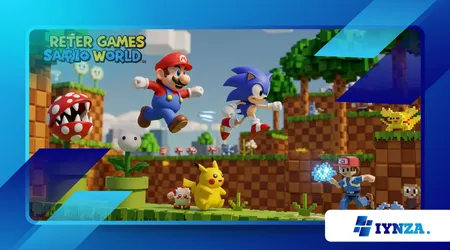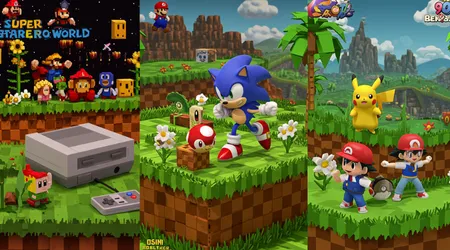Top Retro Games That Defined the ’90s Gaming Era

Retro Games That Defined the ’90s Gaming Era evoke a vibrant nostalgia, transporting players to a time when pixelated screens sparked boundless imagination.
Anúncios
The 1990s were a pivotal decade for gaming, bridging the gap between arcade simplicity and modern complexity.
Consoles like the Super Nintendo, PlayStation, and Sega Genesis shaped a generation, delivering titles that remain cultural touchstones.
This article dives into the games that sculpted the era’s identity, exploring their innovation, cultural impact, and enduring appeal.
Why do these games still captivate us in 2025? Let’s journey through the pixelated past to uncover the magic of Retro Games That Defined the ’90s Gaming Era.
The ’90s were a crucible of creativity, where technological leaps met bold experimentation. Developers faced hardware limitations yet crafted masterpieces that prioritized gameplay over flash.
From Mario’s whimsical adventures to Sonic’s blistering speed, these games weren’t just entertainment they were cultural events. A 2025 Statista survey reveals 45% of 18- to 24-year-olds played retro games last year, proving their timeless pull.
This resurgence isn’t mere nostalgia; it’s a testament to design ingenuity that modern titles often chase. Let’s explore the Retro Games That Defined the ’90s Gaming Era that still resonate today.
Super Mario World: The Pinnacle of Platforming
Super Mario World, released in 1990 for the SNES, redefined platformers with its vibrant world and tight mechanics. Mario’s dinosaur companion, Yoshi, added charm and strategy.
Levels like the Star Road warped players to secret challenges, rewarding exploration. Its colorful 16-bit art and catchy soundtrack became iconic, setting a benchmark for Retro Games That Defined the ’90s Gaming Era.
The game’s open-ended design invited players to linger, hunt secrets, or speed through levels. Unlike modern open-world sprawl, its focused creativity kept every jump meaningful.
++ Hidden Indie Gems You Probably Haven’t Played Yet
Mario’s cape mechanic, allowing flight, felt revolutionary, blending accessibility with depth. Even in 2025, speedrunners on Twitch dissect its levels, proving its lasting challenge.
Nintendo’s genius lay in balancing innovation with approachability. Super Mario World wasn’t just a game; it was a playground of possibility.
Its influence echoes in indie titles like Celeste, which borrow its precise controls. For many, it’s the gold standard of Retro Games That Defined the ’90s Gaming Era, a masterclass in design.

The Legend of Zelda: A Link to the Past
A Link to the Past, launched in 1991, crafted an epic blueprint for action-adventure games. Its dual-world mechanic Light and Dark Hyrule blew minds.
Puzzles, exploration, and swordplay blended seamlessly, making every dungeon a storytelling triumph. This title cemented Zelda’s legacy among Retro Games That Defined the ’90s Gaming Era.
The game’s narrative depth, rare for its time, wove personal stakes into a grand quest. Players flipped between worlds, solving intricate puzzles with elegant simplicity.
Its overworld, packed with secrets, rewarded curiosity, a trait modern RPGs still emulate. In 2025, its influence persists in games like Tunic.
Also read: How to Start Collecting Indie Physical Editions Without Breaking the Bank
Think of Zelda as a well-worn book, its pages dog-eared from countless revisits. Each playthrough reveals new layers, from hidden caves to clever item uses.
Sonic the Hedgehog: Speed as a Statement
Sonic the Hedgehog, debuting in 1991 on the Sega Genesis, was a cultural lightning bolt. Its blazing speed and attitude challenged Mario’s dominance.
Unlike Mario’s measured hops, Sonic’s momentum-driven gameplay thrilled players. Levels encouraged mastery, with shortcuts rewarding skill.
The soundtrack, a synth-pop masterpiece, still inspires remixes on Spotify in 2025. Sonic wasn’t just a game it was a rebellion against the status quo.
Read more: The Best Retro Remakes Made by Indie Developers (Not Big Studios)
The rivalry with Nintendo fueled innovation, birthing a mascot war that shaped the decade. Sonic’s simplicity run fast, collect rings hid surprising depth.
Modern indie runners like Freedom Planet owe it a debt. Sonic remains a cornerstone of Retro Games That Defined the ’90s Gaming Era, embodying pure adrenaline.
Final Fantasy VII: Redefining RPGs
Final Fantasy VII, released in 1997 for the PlayStation, transformed RPGs with its cinematic storytelling. Cloud Strife’s journey through Midgar gripped players emotionally.
Its 3D visuals and Materia system pushed boundaries, earning it a spot among Retro Games That Defined the ’90s Gaming Era.
The game’s narrative tackled eco-themes and loss, rare for the era. Its turn-based combat, blended with strategic Materia combos, felt fresh yet accessible. In 2025, its Remake trilogy keeps its legacy alive, but the original’s raw emotional pull endures.
Imagine FFVII as a time capsule, preserving the ’90s’ shift toward mature gaming. Its blocky polygons, now charming, contrast with modern remakes.
Fan communities on Reddit still debate its plot twists. FFVII’s impact cements it as a titan of Retro Games That Defined the ’90s Gaming Era.
Street Fighter II: The Arcade Revolution
Street Fighter II, hitting arcades in 1991, redefined fighting games with its tight mechanics and vibrant roster. Ryu’s Hadoken and Chun-Li’s kicks became cultural icons. Its competitive depth made it a staple of Retro Games That Defined the ’90s Gaming Era.
Arcades buzzed with players mastering combos, fostering a community that thrives in 2025’s esports scene.
The game’s balance and accessibility birthed a genre, influencing titles like Mortal Kombat. Its pixel art and music remain timeless, celebrated in retro streams.
The game’s genius was its universal appeal anyone could play, but mastery took skill. Tournaments still draw crowds, proving its staying power.
Street Fighter II’s legacy as a pioneer of Retro Games That Defined the ’90s Gaming Era burns bright in every modern fighter.
Pokémon Red and Blue: A Cultural Phenomenon

Pokémon Red and Blue, launched in 1996, sparked a global craze. Collecting 151 creatures and battling friends hooked millions.
The Game Boy’s portability turned Pokémon into a social phenomenon. Kids traded via link cables, building communities that persist online in 2025. Its minimalist design hid surprising depth, with type matchups rewarding strategy.
Pokémon was like a digital campfire, drawing players to share stories and battles. Its influence spans anime, cards, and modern games like Palworld.
The Lasting Legacy of ’90s Retro Gaming
The Retro Games That Defined the ’90s Gaming Era weren’t just products they were cultural milestones. Their simplicity, born of hardware limits, forced creative genius. Modern indie games, like Stardew Valley, channel their spirit, blending nostalgia with fresh ideas.
In 2025, retro gaming thrives on platforms like the Analogue Pocket, which plays original cartridges with crisp displays.
These games’ focus on fun over flash contrasts with today’s bloated titles. Their communities on Reddit, Twitch, and beyond keep the flame alive.
Picture retro gaming as a classic vinyl record, its crackles adding charm. These titles shaped not just gaming but how we connect through play. The Retro Games That Defined the ’90s Gaming Era remain vital, inspiring creators and players alike.
| Game | Console | Release Year | Key Innovation |
|---|---|---|---|
| Super Mario World | SNES | 1990 | Yoshi, open-ended levels |
| A Link to the Past | SNES | 1991 | Dual-world mechanic |
| Sonic the Hedgehog | Sega Genesis | 1991 | Momentum-based gameplay |
| Final Fantasy VII | PlayStation | 1997 | Cinematic storytelling, Materia system |
| Street Fighter II | Arcade/SNES | 1991 | Competitive fighting mechanics |
| Pokémon Red and Blue | Game Boy | 1996 | Social trading, creature collection |
Conclusion: Why These Games Endure
The Retro Games That Defined the ’90s Gaming Era are more than relics they’re blueprints for timeless design. Their focus on gameplay over graphics resonates in 2025’s retro renaissance.
From Mario’s leaps to Pokémon’s trades, these titles built communities and inspired genres. They remind us that great games don’t need 4K visuals just heart.
Today, emulators, remakes, and indie tributes keep these classics alive. Their simplicity offers an antidote to modern gaming’s complexity, inviting new players to discover their magic.
The ’90s taught us that limitations breed creativity, a lesson still shaping gaming’s future. Which retro gem will you revisit next?
FAQ: Frequently Asked Questions
What makes ’90s retro games so special?
Their focus on tight gameplay and creative design, born from hardware limits, created timeless experiences that modern games often emulate.
Why are retro games popular in 2025?
A 2025 Statista survey shows 45% of young gamers play retro titles, drawn to their simplicity and nostalgia-driven community on platforms like Twitch.
How can I play these retro games today?
Use emulators, modern handhelds like the Analogue Pocket, or remakes on consoles. Original cartridges are also collectible but pricey.
Are retro games better than modern ones?
Not inherently, but their focused design offers a refreshing contrast to today’s complex titles, appealing to players seeking pure fun.
